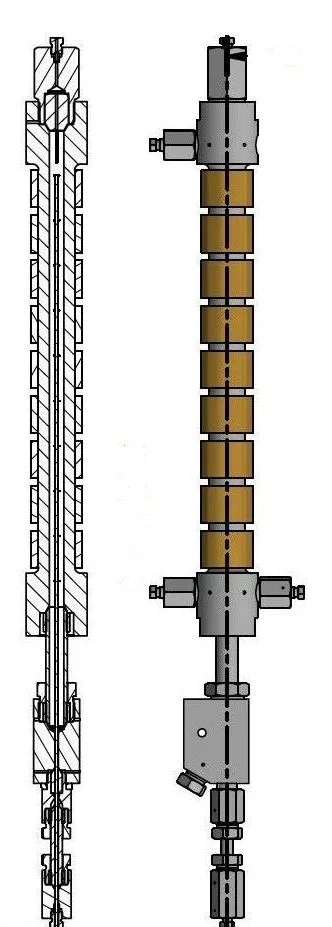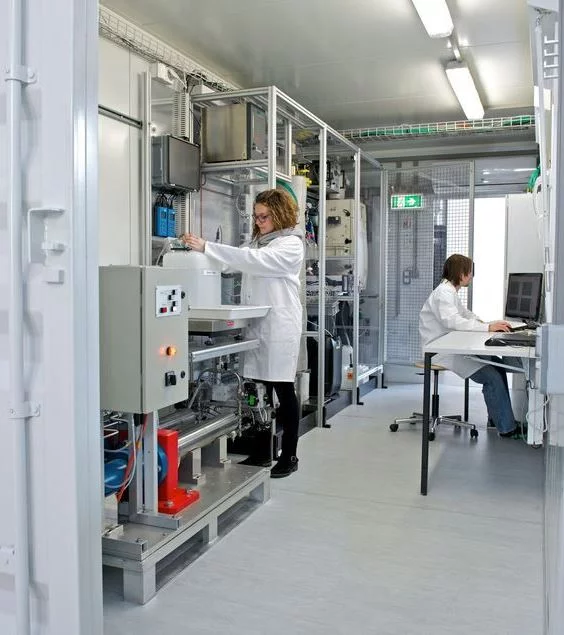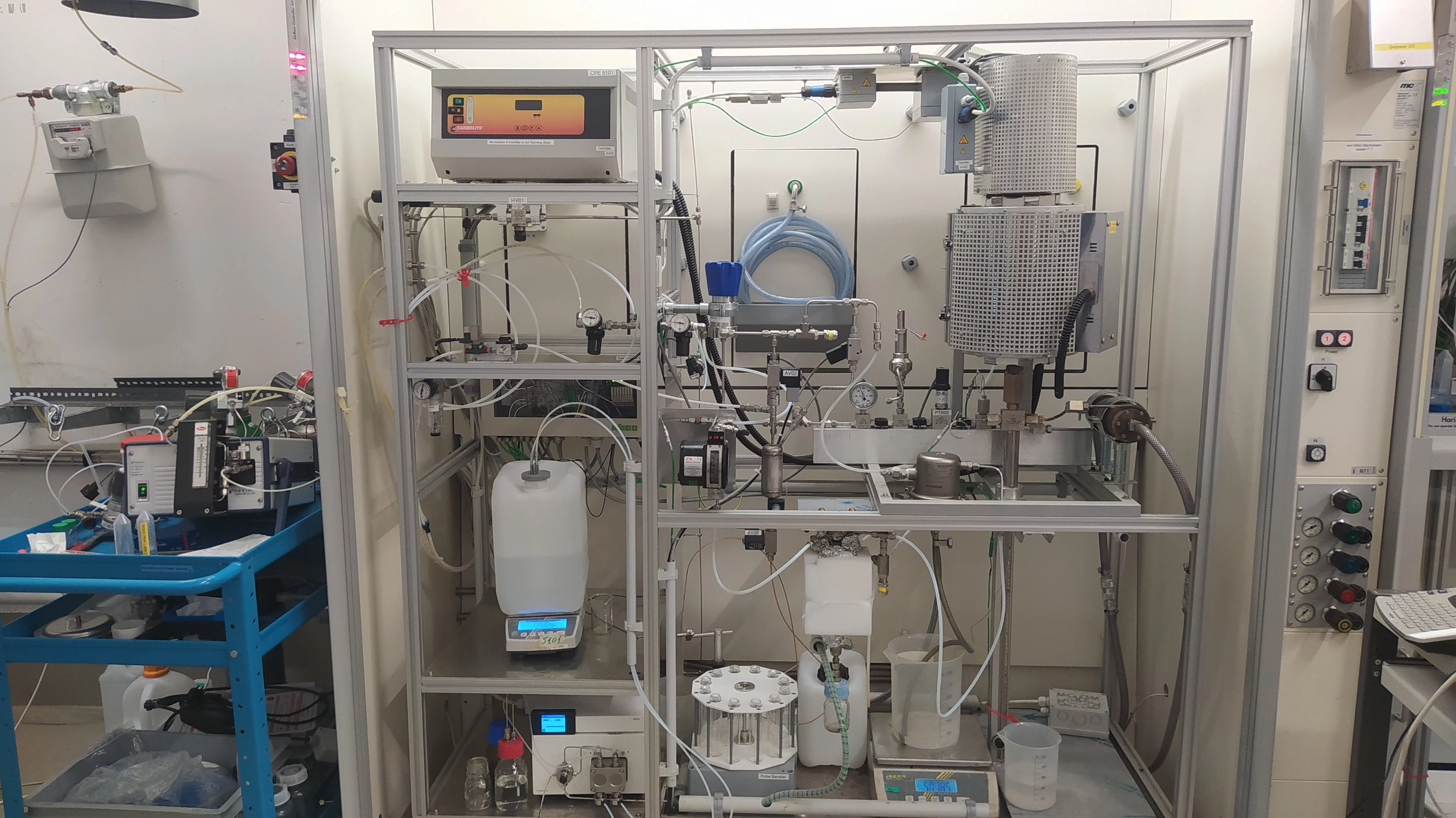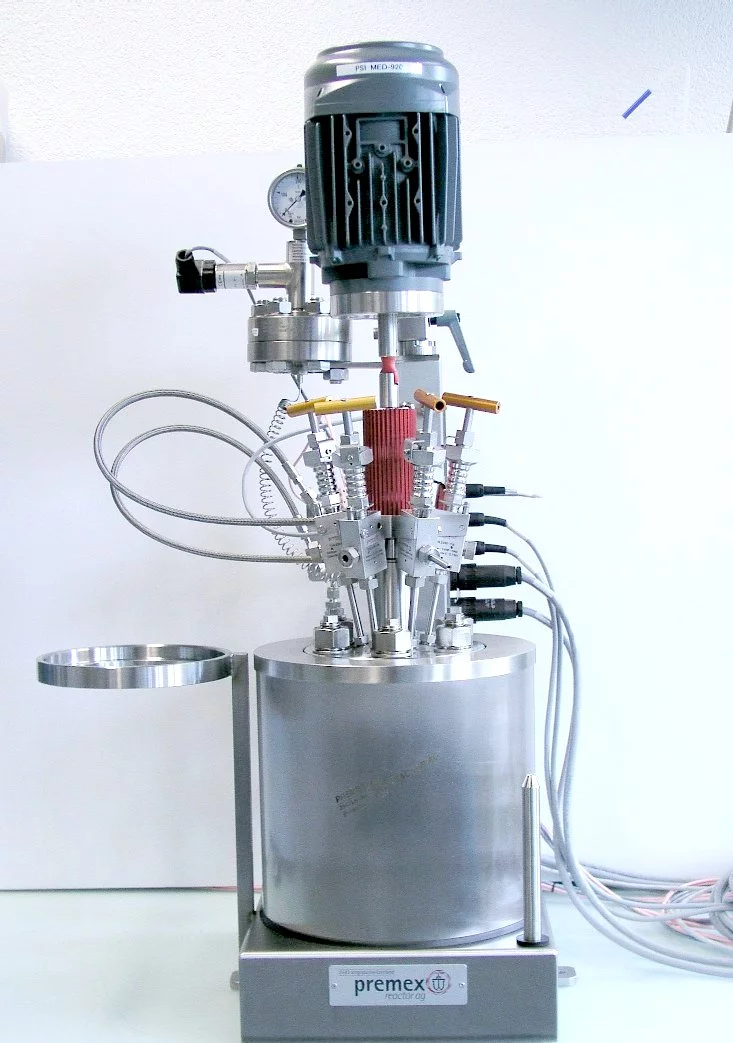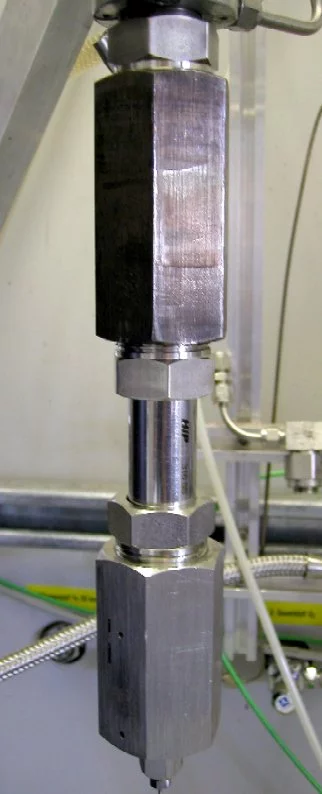Salsan-II
Description
Central to the set-up is a dip-tube salt separator. The special "zircalloy" vessel was reused from the 2005 salsan campaign at the NEUTRA beamline. In this previous study, salt separation was visualised using neutron radiography. Zircalloy was used as construction material as it is transparent for neutrons.
The objective of this set-up is to study the separation and deposition of salts under hydrothermal conditions and to obtain data that complement CFD simulations of the flow inside the salt separator.
Characteristics of the set up
- Up to 320 bar
- T max. 450°C
- V* = 20 ml/min.
- Vessel volume ca. 50 ml
- 9 individually controlled vessel heaters
KONTI-C
Mobile gasification plant. For more information see the project page KONTI C
Features of KONTI-C:
- Biomass pumped as a slurry (up to 10 wt. % of DM) at 1 kg/hours
- Pressure max = 40 MPa
- Temperature max = 550 °C
- New salt separator design (patented)
- Gaseous effluents analysed online by a MicroGC
- Liquid effluents analysed online by TOC and conductivity
- Highly automated (liquid sampling, temperature profile measurements) and remote controlled.
KONTI-I
The continuously operating catalyst test rig is built for catalyst long term testing under hydrothermal conditions. As two HPLC pumps are responsible to provide system pressure, only liquids can be used as reactants. A mixture of several substances simulates liquefied biomass. The ratio of biomass to water can be chosen as they are fed separately and mixed only later in the plant. The water is heated to the desired temperature before mixing.
The biomass-water-mixture is sent to the fixed-bed reactor that can be filled with different types of catalysts to be tested. After a pressure regulation valve and a phase separator, the liquid products can be examined with our TOC apparatus in terms of carbon content or with HPLC-HRMS to identify chemical compounds. The gas is sent to a micro gas chromatograph and is being analyzed it in a continuous way.
Characteristics:
- Liquid biomass model substances
- Pmax 40 MPa
- Tmax 550 °C
- Ratio biomass / water variable
- Long-term catalyst stability testing possible
- Online GC analyses, offline TOC and HPLC-HRMS analyses by sampling
High Pressure Autoclave
The autoclave is suitable for performing reactions in a high temperature pressurized environment. It is equipped with a gas inlet stirrer so there is an ideal mixing of the reactants even if the reaction mixture is a multi phase system, e.g. a gaseous, a liquid an a catalyst phase. Temperature and pressure within the autoclave are monitored online. Therefore the autoclave can be used to measure reaction kinetics for reactions with gaseous reactants or products.
Characteristics:
- Volume = 422 ml
- Pmax = 325 bar
- Tmax = 500 °C
- Online monitoring of temperature and pressure
Salsan
Vessel for the separation and precipitation of ionic species from supercritical water. This vessel has been built from nuclear-grade Zircaloy-2, which renders it nearly invisible to neutrons. Because of this, neutron transmission radiography can be used to visualize the precipitation and transport behavior inside of the vessel while it is operating at high-temperatures and pressures.
The vessel is built in a continuous flow system with the following characteristics:
Fed with a pulseless HPLC pump capable of 1-10 mL/min. Preheater capable of heating the feed to 350°C, maintaining the fluid at slightly subcritical conditions so that precipitation does not occur before the Salsan vessel. Separate heater controls for the top and bottom of the vessel. In normal operation, the bottom zone is kept at a lower temperature to allow brine to accumulate in this zone. The top zone is kept supercritical for salt separation. Online monitoring of conductivity for indication of salt removal efficiency. The vessel is constructed so that fluid enters at the top through a dip-tube. The fluid flow reverses as it is heated to supercritical conditions. Meanwhile, salts precipitate either as solids or as a brine and settle to the bottom of the vessel.
Catalytic reactor for in-situ XAS under supercritical water conditions
A catalytic reactor for in-situ XAS under supercritical water conditions was constructed from aluminum nitride (see Figure 1). This material presents a mechanical strength similar to sapphire and exceptionally high heat conductivity. Furthermore, it transmits X-ray radiation without causing diffraction, due to its polycrystalline nature. The tubular design, where the entire reactor is made of aluminum nitride, has a clear advantage over window-type reactors: it allows for spatial resolution along its entire length.
The reactor can be used at pressures of up to 300 bar and temperatures of up to 450°C. This allows for reaching the supercritical state of most gases and liquids, including water. It was pressure-tested at 300 bar at room temperature for 3 hours in our high pressure lab and operated almost continuously at 245 bar and 400°C for 5 days. During that time, no material failure occurred, nor could any degradation of the reactor material be observed. An electrical power of 120 W was sufficient to heat the catalytic zone of the reactor to 400°C at a rate of 4 K/s whilst water was fed at a flow rate of 0.5 ml/min. Since aluminum nitride has a high temperature shock stability, experiments involving fast heating-cooling cycles are not expected to present a problem.
HydroBatch
The batch reactor is suitable to pre-test catalysts for activity and stability or for carrying out biomass liquefaction and gasification experiments. An advantage is that real biomass can be used up to a high solids content.
Characteristics:
- Volume approx. 30 mL
- Pmax 40 MPa
- Tmax 550 °C
- Possibility of addition of inert or a reactive gas (e.g. O2, H2)
- Heating by immersion into fluidized sand bath (heat up rates 5 – 40 K / min)
- Quenching after reaction by immersion into water bath
- Shaking mechanism to mix the contents in the presence of solids (e.g. a catalyst)


